Introduction
I’m a big fan of virtualization. It enables multiple computing functions to run on the same hardware, saving electricity and space, reducing heat and noise output and improving network operations and efficiency. The challenge with virtualization is ensuring the hardware running the virtual machines (VMs) has enough processing power and memory to deliver the required performance, yet still generate all those savings.
Processors and memory capacity in NASes are increasing and more NAS vendors are adding support for running VMs. Running one or more virtual machines on a NAS makes a ton of sense if the hardware can support it. Why not use the NAS’ excess computing power to run virtual machines instead of running multiple boxes?
QNAP’s Virtualization Station add-in application is a good example. Here’s a quick rundown of its features:
- Multiple OS support
- Run multiple OS and NAS simultaneously
- Dedicated network access for VMs
- Browser access to VMs
- VM to NAS Direct Storage access
- Operate VMs with physical keyboard, mouse and monitor
- VMs can have direct access to USB devices
- Fast virtual machine creation
- Virtual machine import/export
- Snapshot function
- Energy-saving & Eco-friendly
Depending on the model, Virtualization Station can simultaneously run 1-8 VMs. In this review, I’m going to take a look at QNAP’s Virtualization Station using a QNAP TS-453 Pro NAS.
Installation
QNAP describes Virtualization Station as a hosted hypervisor, meaning it is an application running on top of QNAP’s operating system (QTS), instead of a bare metal hypervisor running directly on hardware. To run Virtualization Station, you only need to have the right model of QNAP NAS, and install the application. QNAP states Virtualization Station requires QTS 4.1 and at least 4 GB or RAM, although the TS-x51 NAS supports Virtualization Station with 2 GB or RAM.
QNAP provided a TS-453 Pro for this review. It’s a 4-bay NAS with 2.0 GHz Celeron quad core CPU and 8 GB of RAM. A quad core processor and 8 GB of RAM seems like a healthy amount of computing power for a 4-bay NAS. Interestingly, the TS-453 Pro is considered an entry level QNAP NAS for virtualization as shown in the chart below.
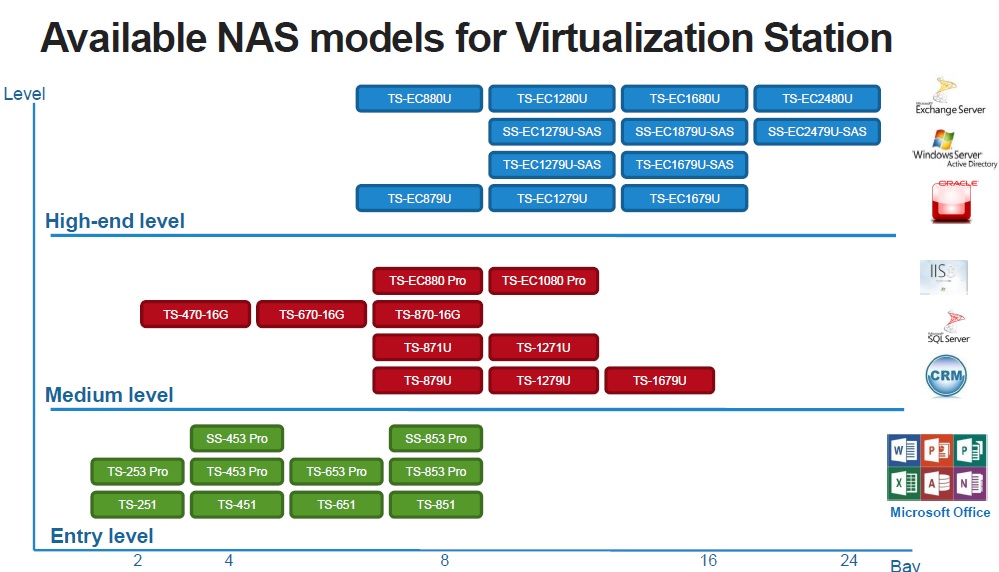
QNAP Virtualization Support
Applications are installed on the NAS with just a few clicks. Just log into the QTS Desktop, select App Center, select Virtualization Station and click Add To QTS. Installation is automatic from there. For my tests, I ran Virtualization Center version 1.2.2312 on QTS 4.1.1.
Creating a VM on Virtualization Station is straightforward. The TS-453 Pro has four Ethernet interfaces. One is reserved for the NAS, the rest can be allocated to the NAS or to VMs. I left Ethernet1 allocated to the NAS and allocated Ethernet2 for VM use.
VMs can be created with various amounts of CPU and memory with predefined templates including micro, mini, small, medium and large, as shown below. You can also allocate custom amounts of CPU and memory to each VM.
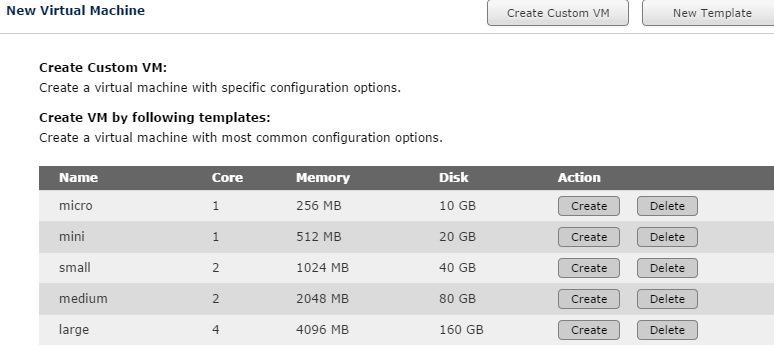
VM Templates
To create the VM, give it a name, choose an OS type and version, create a console password, identify the path the OS image and identify where the VM HD will be created. I built a Linux VM using the small template, which allocates 2 cores of the CPU, 1 GB RAM, and 40 GB of hard disk space to the VM. The screenshot shows the options I selected for my Linux VM.
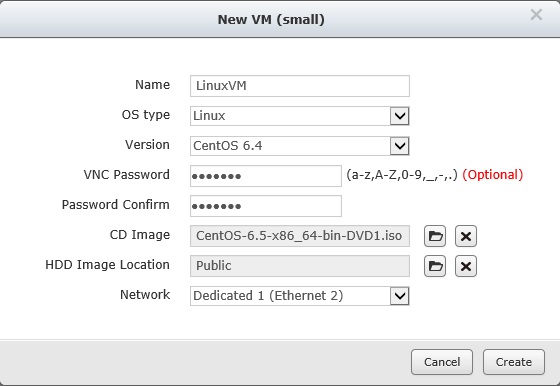
Small VM Template
Virtualization Station supports multiple OSes as VMs, including Android-x86, Linux, Unix, and Windows and multiple versions of each OS are recognized. For example, CentOS Linux is supported up to version 6.4. But I used CentOS version 6.5, which worked fine. It took me less than 10 minutes to have a fully functional Linux VM running on the TS-453 Pro.
Once I had my Linux VM running, I created a Windows VM. I built a Windows VM using the large template, which allocates 4 cores of CPU, 4 GB of RAM and 160 GB of hard disk space to the VM. Virtualization Station recognizes Windows 8.1, 8, 7, Vista, XP, and Windows Server 2012, 2008 and 2003. The Windows 7 image I used was a bit outdated, so the install took longer to complete the Windows upgrade process. But the end result was a fully functional Windows 7 VM running on the TS-453 Pro.
Managing VMs
VMs are often managed via network applications such as telnet, ssh, VNC for Linux or RDP (Remote Desktop) for Windows. With Virtualization Station, you can also run and manage multiple virtual machines via a browser. I found it quite efficient to have the QNAP QTS operating system running on one browser tab and an additional tab for each VM console.
The Virtualization Station browser interface provides options to view status, create, import and export Virtual Machines (VMs), adjust network settings, take VM snapshots, review log messages, edit preferences, perform account management and visit a VM marketplace. A console window is available for each VM by clicking a console icon.
I used IE11 and got the error message shown below when I started a browser window for VM console access. The message states Chrome, Firefox, and IE10 are the only supported browsers. Nevertheless, I used IE11 and had no issues with console access to multiple VMs.
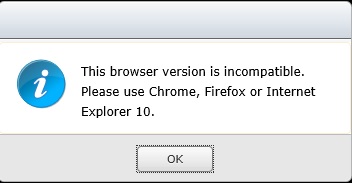
Supported Browsers
The console window opens via a browser and gives you full KVM (Keyboard, Video, Mouse) access to the OS. Below is a screenshot of the console window for the Linux VM…
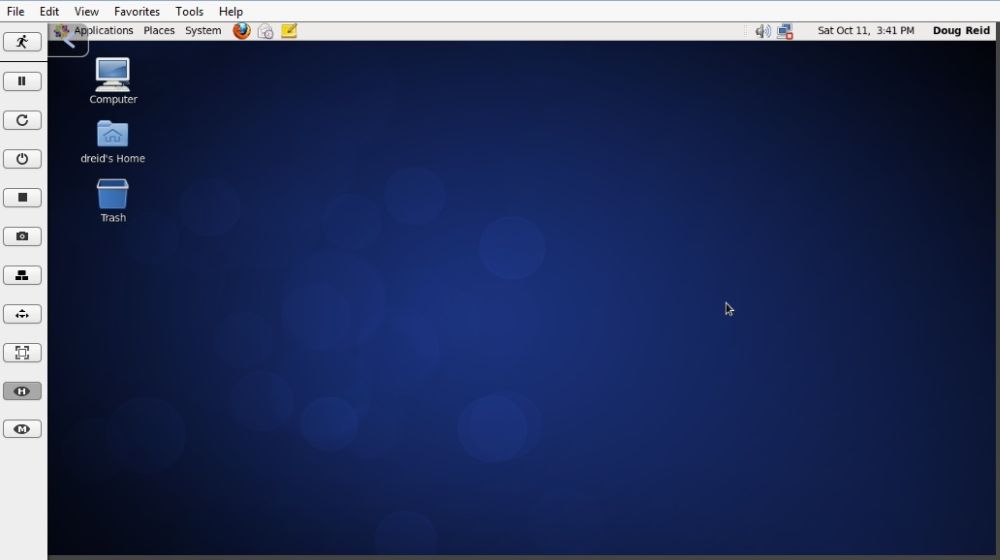
Linux Console
…and a screenshot of the console window for the Windows 7 VM.
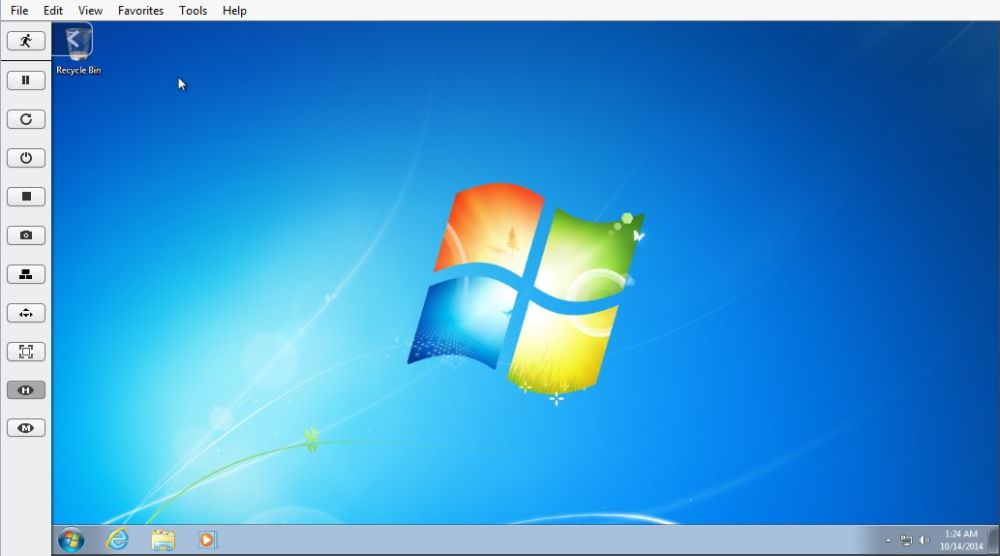
Windows Console
Storage
Running a VM on a NAS means the VM can have direct access to storage on the NAS. Virtual hard drives for the VMs in Virtualization Station are created on the NAS itself. Virtualization Station’s default virtual hard drive uses a virtual IDE controller. But you can customize that hard drive and/or add additional storage for your VM using virtual SCSI, SATA, or VIRTIO controllers.
The VIRTIO controller provides higher disk I/O performance than the virtual IDE or SATA using a special driver included in Virtualization Station. Additionally, storage on the NAS can be accessed by the VM via iSCSI, which is a means of creating IP-based storage that appears as local storage on the VM. (QNAP has a nice tutorial on setting up iSCSI storage here.) Further, if the storage designated to a VM needs to be expanded, Virtualization Station allows for adding additional virtual drives to the VM.
I set up my Linux and Windows VMs with the default IDE controller. I also added a mapped network drive to access the NAS. Both worked well, although the mapped network drive is somewhat inefficient as reading and writing data to/from the VM and NAS entails going in and out two Ethernet interfaces on the same box.
KVM Access
A neat aspect of Virtualization Station is that you can use your VM like a physical PC with a physical keyboard, mouse and monitor. QNAP’s QvPC technology enables direct access to a VM with USB keyboard, mouse and HDMI monitor. Physical ports on the TS-453 Pro include three USB 3.0 ports, two USB 2.0 ports and an HDMI port.
To use a physical keyboard, mouse and monitor with a VM, you need to enable QNAP’s HD (Hybrid Desk) Station application and the QVM application within HD Station. As with the Virtualization Station application, QTS does the hard work. All you do to install HD Station is find the application in the App center, select it and let it download and install. You also select which VMs can use the QVM application in the VM Preferences page, shown below.
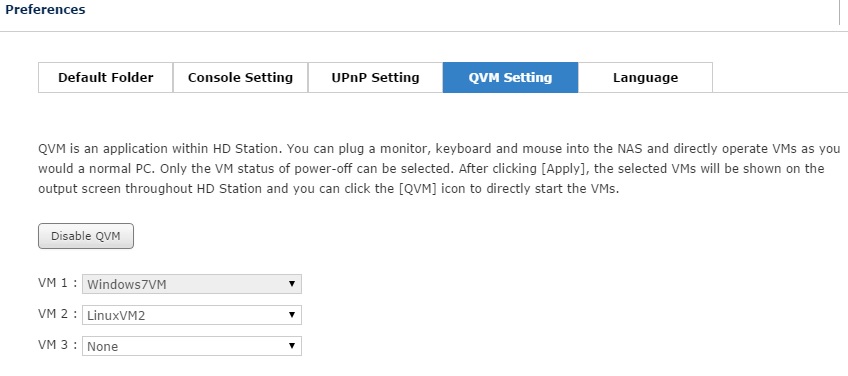
QVM Options
With HD Station installed and QVM configured, I connected a USB keyboard and mouse, as well as an HDMI TV to the TS-453 Pro. I selected the input on my TV to the HDMI cable connected to the TS-453 Pro and was presented with a screen that allowed me to select from multiple QNAP applications. All of these options were manageable with my USB keyboard and mouse.
Once I selected a VM, the VM desktop was displayed on my HDMI monitor and was manageable with a USB keyboard and mouse. The only issue I had was screen resolution. My HDMI TV is 1920×1080 and the HD Station application resolution was set to 1920×1080, but the desktop image slightly exceeded the screen on my TV, making it difficult to click top corner window options as well as applications in the bottom desktop tray. Notice in the image below how the Windows start button is partly visible in the bottom left.
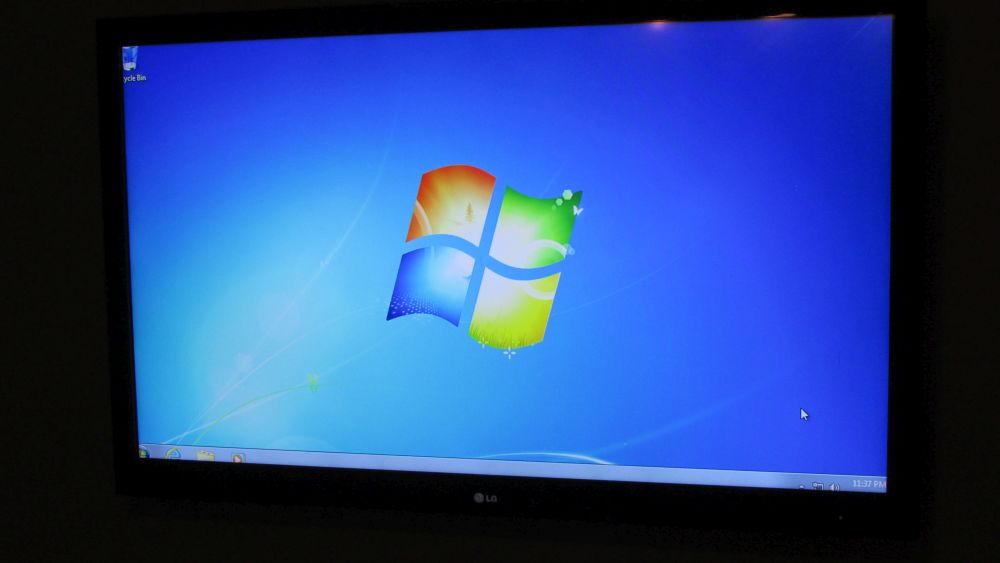
Screen resolution problems
VM Import and Export
Creating a VM involves installing an operating system and then installing desired applications, which can be time consuming. In many cases, this work may have already been done and is available for download. Virtualization Station supports .ovf and .ova formats for importing VMs and .qvm and .ovf formats for exporting VMs. Further, Virtualization Station can import VMs you’ve already created or downloaded from providers such as VMware and BitNami. There are links to both the VMware and BitNami marketplaces in Virtualization Station.
QNAP put together a nice tutorial on importing and exporting VMs. I followed the tutorial to successfully import a WordPress VM running on Linux from BitNami. I downloaded the VM using a PC and saved it directly to the TS-453 Pro. Once I extracted the.zip file, I was able to import and run this VM directly in Virtualization Station. The screenshot shows WordPress running as a VM in Virtualization Station.

Imported WordPress VM
I also followed the steps to export the Linux VM I created earlier. This process involved using the Virtualization Station export option, then opening the exported VM in another hypervisor. I used VMware Player as a hypervisor to run the VM I created with Virtualization Station.
VM Options
Other options supported by Virtualization Station include creating and restoring from Snapshots, scheduled VM starts upon NAS boot up, direct USB device connection to VMs and user based permissions to protect VM resources. Further, within Virtualization Station, there is a useful dashboard, shown below, which displays resource utilization and current status of each VM.
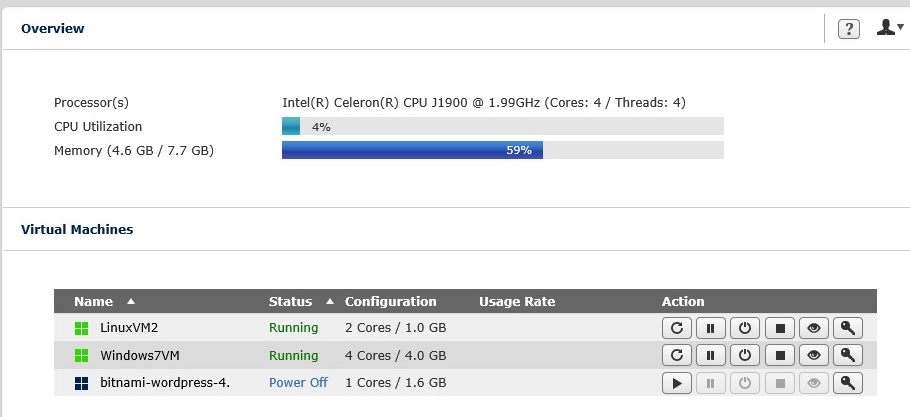
VM Dashboard
Performance
So all this virtual goodness is great, but not if it runs dog slow. So I checked to see how well the TS-453 Pro supported both native NAS functions (file read and write) while running one or more CPU-intensive virtual machines.
A running too many virtual machines will impact NAS performance was displayed when I started a second VM. Although I didn’t experience any performance issues while running multiple VMs, I accepted this message as a challenge.
I ran two VMs simultaneously on Virtualization Station: the WordPress Linux VM and my Windows 7 VM. I ran PS3 Media Server on the Windows 7 VM to transcode and stream 720p .mkv files to a PS3 while copying a large file from another PC to the TS-453 Pro. While this was going on, I watched the QTS utility that lets you monitor CPU utilization on the TS-453 Pro. As you can see below, the TS-453 Pro’s quad-core CPU hit 75%, but that’s as high as it went.
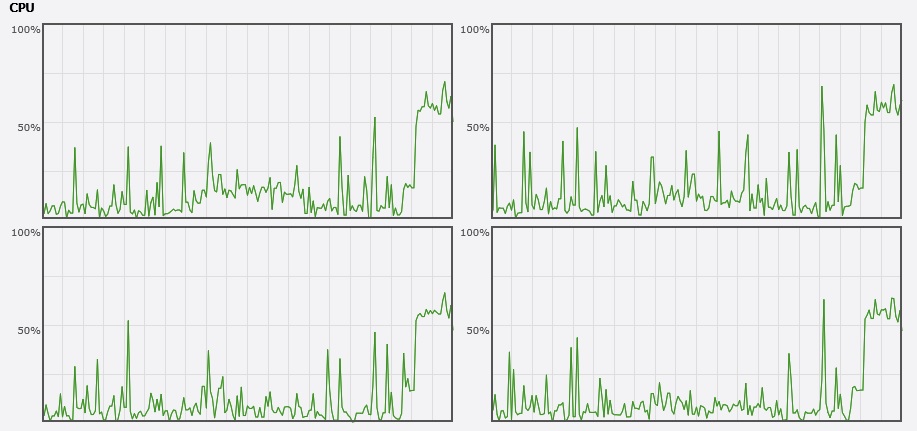
CPU Monitor
I was impressed! I can report that video playback didn’t degrade from HD resolution and remained clear and completely smooth. Further, the simultaneous file copy operation ran at 97 MB/s.
In my experience, video transcoding and streaming has been enough to peg the CPU on my hardware video server (laptop with a 2.0 GHz Core 2 Duo CPU, 4GB RAM, Win 7 Pro). So I expected transcoding and streaming would max out the TS-453 Pro’s CPU. I also expected adding the file copy operation would spike the CPU or cause performance issues. Clearly, that wasn’t the case.
Closing Thoughts
Effective virtualization involves gaining efficiency without compromising performance. QNAP’s Virtualization Station definitely meets this goal. With one box, I was able to run Linux and Windows virtual machines while retaining full NAS features and plenty of performance. Whether you are a VM newbie or seasoned pro, QNAP’s Virtualization Station will have you running VMs in no time!
